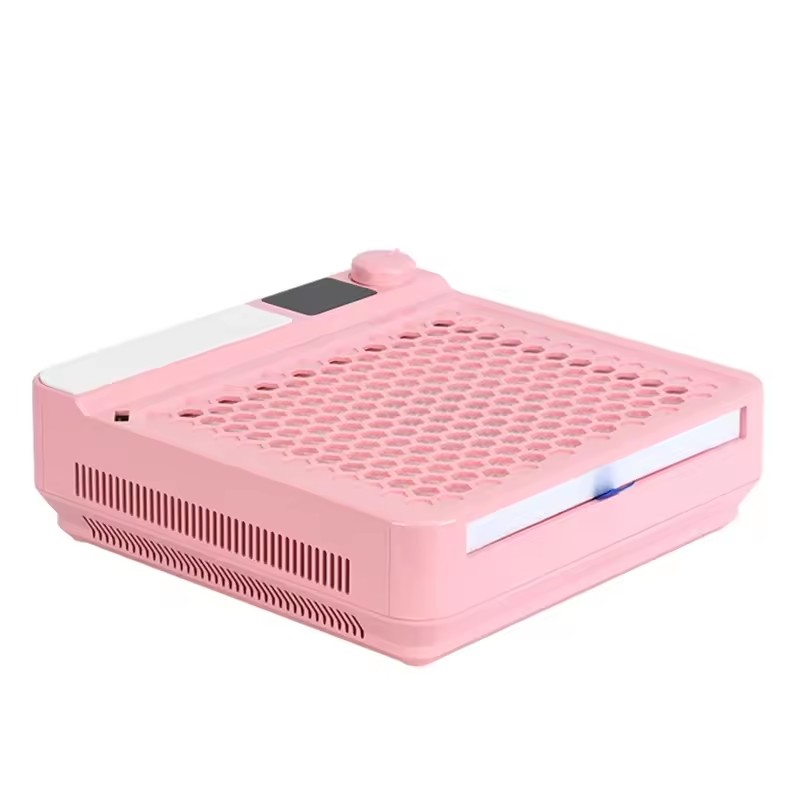How Does a Nail Dust Machine Improve Safety and Comfort in Nail Care?
2025-09-26
In the world of nail care, whether for professional salons or at-home beauty enthusiasts, one challenge stands out—dust. Filing, buffing, and shaping nails produces fine particles that are almost invisible to the eye but highly disruptive to the lungs, skin, and workspace cleanliness. A Nail Dust Machine addresses this issue directly, creating a cleaner and healthier working environment while enhancing client comfort.
So, what exactly is a nail dust machine? It is an electric-powered suction device designed to capture and filter the dust generated from manicures, pedicures, and artificial nail applications. Unlike traditional nail services where technicians rely on masks or manual cleaning, a nail dust machine actively eliminates airborne debris at its source.
Why does it matter? Because dust from acrylic nails, gel nails, and natural nail filing can trigger allergies, respiratory irritation, and even long-term health issues if inhaled continuously. Clients often notice discomfort as well, especially during long sessions. By using a Nail Dust Machine, both safety and comfort rise significantly, which is why it is increasingly considered a professional standard in nail salons.
Moreover, nail care has become more intricate over the years. From creative nail art to advanced sculpting, the need for precision has grown. A dust-free environment ensures better visibility and less interference, allowing technicians to deliver flawless results. This is why the adoption of nail dust machines has accelerated worldwide and why clients often prefer salons equipped with them.
How Does a Nail Dust Machine Work and What Are Its Key Features?
To understand how this device transforms nail care, we must look at its mechanism and design. A Nail Dust Machine typically integrates suction power, filtration technology, and ergonomic features to ensure performance and usability.
Working Principle:
-
Suction System – The machine creates airflow that pulls nail dust particles directly from the filing surface.
-
Filtration System – Fine filters, often HEPA-grade, trap even the smallest particles.
-
Airflow Release – Clean air is released back into the room, maintaining a breathable environment.
Professional Parameters of Nail Dust Machine:
| Parameter | Specification Range |
|---|---|
| Suction Power | 40W – 80W |
| Airflow Rate | 300 – 450 m³/h |
| Filtration System | HEPA + Sponge Layer |
| Noise Level | 45 – 60 dB |
| Voltage | 110V / 220V |
| Dust Bag / Filter Capacity | 1–2 Liters |
| Operating Time | 8–10 Hours Continuous |
| Weight | 1.5 – 3 kg |
These parameters ensure that technicians can choose a machine that aligns with their workload, workspace size, and noise tolerance. For instance, a salon serving multiple clients daily benefits from a high-airflow model with replaceable HEPA filters, while a home user may prefer a compact, lightweight version.
Key Features:
-
High Suction Efficiency: Captures dust instantly, reducing airborne spread.
-
Adjustable Power Levels: Allows customization based on nail type and service.
-
Quiet Operation: Maintains a calm salon atmosphere without disruptive noise.
-
Reusable or Replaceable Filters: Ensures hygiene while minimizing running costs.
-
Ergonomic Design: Compact structure fits easily on a workstation.
-
Long Operating Life: Engineered for extended usage without overheating.
By combining these elements, the machine delivers not only practicality but also professional-grade hygiene. This explains why more salons are adopting them as a standard part of their service setup.
Why Should Nail Salons and Home Users Invest in a Nail Dust Machine?
The decision to integrate a Nail Dust Machine into nail care routines is backed by strong benefits that extend beyond cleanliness.
Health and Safety Benefits:
-
Protects Respiratory Health – Nail dust particles, particularly from acrylics and gels, can accumulate in the lungs over time. A dust machine minimizes this risk significantly.
-
Reduces Allergic Reactions – Both technicians and clients are less likely to experience sneezing, coughing, or eye irritation.
-
Prevents Cross-Contamination – Dust can carry microbes. Proper filtration reduces potential hygiene issues.
Professionalism and Client Experience:
-
Enhanced Salon Image – A salon equipped with a dust machine appears more modern, responsible, and client-oriented.
-
Improved Service Quality – Clearer visibility during nail art and shaping ensures precision results.
-
Customer Comfort – Clients notice the cleaner air and feel safer during treatments, encouraging repeat visits.
Cost Efficiency:
-
Reduced Cleaning Effort – Less time is needed for wiping surfaces, freeing up technicians for more clients.
-
Long-Term Savings – Protecting staff health means fewer sick days and medical expenses.
-
Durable Equipment – With proper maintenance, a nail dust machine lasts for years, making it a cost-effective investment.
Why It Matters for Home Users:
While salons benefit most, at-home users also see advantages. Many beauty enthusiasts perform their own manicures and pedicures, often in small, enclosed spaces. Without dust control, particles linger longer in the air and settle on furniture. A compact dust machine keeps the environment clean and protects family members from exposure.
From a health, professional, and financial perspective, the Nail Dust Machine is not just optional but increasingly essential for quality nail care.
What Should You Know Before Buying a Nail Dust Machine?
Choosing the right model requires careful consideration of several factors. Not every machine is built the same, and user needs vary.
Factors to Consider:
-
Power and Airflow – Higher power ensures stronger suction, but balance is key to avoid noise discomfort.
-
Filter Type – HEPA filters are recommended for trapping ultra-fine particles. Look for washable or replaceable options.
-
Size and Portability – Compact models suit personal use, while larger machines are better for salons.
-
Noise Levels – Ensure the device operates quietly, particularly if used for long sessions.
-
Maintenance Requirements – Check how often filters or dust bags must be cleaned or replaced.
-
Durability – Sturdy construction ensures long-term service without frequent breakdowns.
-
Price vs. Features – Evaluate whether the machine offers the right balance of cost and functionality.
Practical Usage Tips:
-
Always clean or replace filters regularly to maintain suction performance.
-
Position the machine close to the filing area for maximum efficiency.
-
Run the device during and after sessions to ensure lingering particles are removed.
-
Store in a dry environment to protect electronic components.
By applying these guidelines, buyers can secure a model that fits their needs while guaranteeing long-term value.
Frequently Asked Questions (FAQ)
Q1: What is the main function of a Nail Dust Machine?
A Nail Dust Machine is designed to capture and filter fine dust particles produced during manicures and pedicures, keeping the air clean and protecting both technicians and clients.
Q2: How often should I replace the filters?
Filter replacement depends on usage. For salon environments, filters should be replaced every 2–3 weeks. Home users may extend this to every 1–2 months. Washable filters can last longer if maintained properly.
Q3: Can a Nail Dust Machine eliminate odors as well as dust?
While primarily built for dust removal, high-quality machines with multi-layer filters can also reduce mild odors, but they are not a full replacement for proper ventilation systems.
The Nail Dust Machine has become a vital tool in today’s nail care industry, bridging the gap between health protection and professional service quality. It ensures cleaner air, enhances comfort, and demonstrates a commitment to hygiene and client safety. Whether for a busy salon or home beauty station, its advantages are undeniable.
For those seeking reliability, durability, and excellent filtration, Baiyue offers advanced Nail Dust Machines engineered for professionals and enthusiasts alike. Built with precision and user-friendly design, these machines deliver consistent performance and long-term value.
To learn more about our full range of Nail Dust Machines or to request product details, please contact us today.



